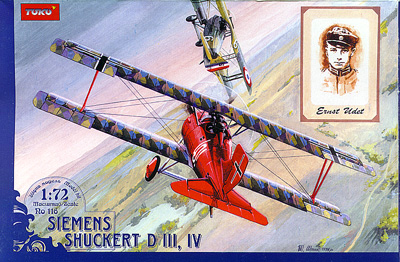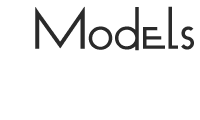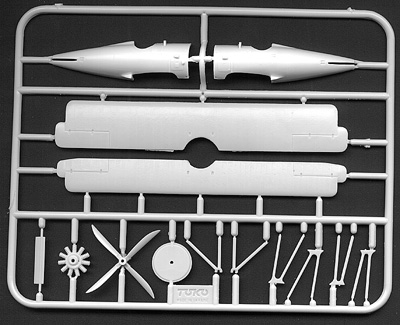This site is best
viewed at 800x600
and 16 bit color.
 |  |
| Toko Siemens Shuckert D.III/D.IV | Quick Review |
| The Siemens Shuckert D.III/D.IV was a late-war addition to the German air arm. Like the Pfalz D.XII, the SSW D.III was intended to help fill the gap made by the slow production of the Fokker D.VII. The SSW D.III incorporated a different engine/propellor arrangement, with the rotary engine rotating in the opposite direction of the propellor. This helpt to counteract the torque moment and gave the SSW D.III better stability and performance. Unfortunately, the engine arrangement broke down frequently, reducing its effectiveness. The D.IV was basically the same airframe, but featured a smaller upper and lower wing.
The kit is molded in light gray, and features parts to make both the D.III and the D.IV. There is some light flash, but nothing too difficult to take care of. The struts and propellor are very finely molded, and are of realistic thinness. The engine has decent detail, but could probably stand to be replaced by a white metal one. The interior is fairly nice, featuring sidewall detail, seat, control stick, and rudder pedals. Some careful painting is just about all that's needed in there, as you won't be able to see much else. The guns are about as good as you can get with injection plastic, and are more than adequate representations of the Spandaus.
The separate wings for the D.IV require some small fuselage modification. Since the lower wing is so much narrower than the D.III wing, there is a fillet on the fuselage for the D.III wing that will need to be sanded off. This is no big deal, and having the option of doing either the D.III or D.IV in one kit is to be commended. It seems too many manufacturers are making two kits with subtle variation changes instead of including those options in the kit, which is sad.
The decals for the SSW D.III/D.IV are very nice, and, like the Pfalz D.XII, include a full set of lozenge decals. Unfortunately, also like the Pfalz D.XII, the colors are wrong, and there is no difference between the upper and lower patterns. The marking choices given are for Ernst Udet's famous "LO!" D.III and a D.IV of Oberleutenant Alfred Lerner. This last one is something of a typo, however. On the box and instructions, he is identified as Lerner, but on the decal sheet itself, he is correctly identified as Alfred Lenz. Udet's D.III is definitely the more colorful of the two, being finished with the fuselage and tailplanes in bright red, with the wings left in the standard lozenge pattern. The phrase "LO!" is in white on each side, making for a very striking airplane. If Toko keeps up this quality, they will quickly up the ante for low-cost, high-quality kit production. Out of the box, this kit can easily be built up into a sharp little model, and with a couple of white metal replacements (engine and guns), you can have a show-stopper, and at a fraction of the cost of a new Hasegawa kit. I highly recommend this kit, even if it would be your first WWI model. Chris Banyai-Riepl |  Color Painting Guide
|




